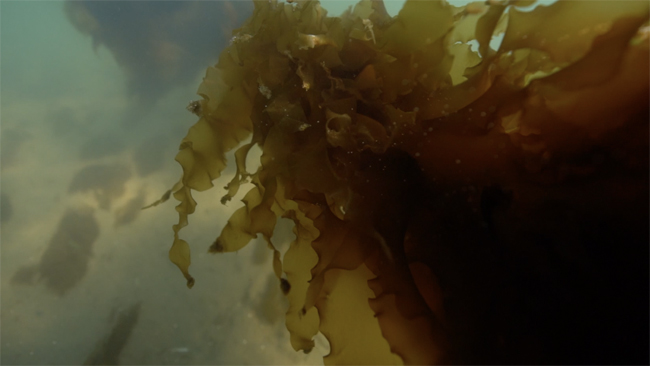The seaweed can absorb CO2
— By Bo Evans, Denver7 News
Stony Brook, NY, March 19, 2021 - There’s a lot of solutions out there that people like to talk about when it comes to climate change, but one that’s gaining a lot of traction is kelp.
The seaweed is more than just a slimy sushi wrap. It could be key to fighting climate change. Just ask Michael Doall, the Associate Director for Restoration & Aquaculture at Stony Brook University.
“Not only is the kelp soaking up nitrogen, it’s soaking up carbon. It’s doing photosynthesis just like plants on land, soaking up this carbon. So, it’s sequestering this carbon, taking it out of the water and then again, when we harvest the kelp, we’re removing that. We’re approaching one of our farm sites and it’s part of this study over the last three years. We’re helping farmers learn how to grow kelp and integrate kelp in their oyster farms,” said Doall.
Doall and his crew took us to see one of their kelp farms off the coast of Long Island. We joined them with some waders to get a closer look.
“Reach in, grab that line and just lift it up. We seeded this at the end of December,” Doall explained.
And we got to taste it too.

Credit: Drew Snadecki, Photo Journalist, Denver Channel
Back on shore, Doall's partner, Chris Gobler, the Endowed Chair of Coastal Ecology and Conservation at Stony Brook, explained why kelp is such an important asset in the fight against climate change.
“Most of the research I’ve done is on environmental pollution, things like climate change, ocean acidification, harmful algal blooms, overloading of nutrients. And as it turns out, seaweeds, and in particular kelp, is sort of the remedy for all of these environmental insults,” Gobler explains.
Like Doall said earlier, one of the main things the seaweed does is absorb nitrogen and carbon in the water. CO2 in the ocean can make the water more acidic, which can cause damage in a number of ways, but it’s incredibly detrimental to shellfish.
That's why oysters may go better with kelp than cocktail sauce.
“Ocean acidification is the biggest threat to animals that make shells. You can create what we’d call a halo effect. So, you’d have a particular area where maybe the whole estuary is getting acidified, but in that area where you’re farming the oysters, where you have the kelp, you’re actually creating sort of a refuge,” said Gobler.
We wanted to get an even closer look at the kelp, so we dove in.
It’s an amazing plant that can grow incredibly fast. Doall expects the long string blades to be up to 12 feet long in a few months. They thrive in the icy waters.
Kelp isn’t the only solution to fight climate change, but Doall and Gobler hope it can be another tool for humans to use in this fight to save the planet.
More Info: New York Sea Grant
New York Sea Grant (NYSG), a cooperative program of Cornell University
and the State University of New York (SUNY), is one of 34 university-based
programs under the National Oceanic and Atmospheric Administration’s
National Sea Grant College Program.
Since 1971, NYSG has represented a statewide network of integrated
research, education and extension services promoting coastal community
economic vitality, environmental sustainability and citizen awareness
and understanding about the State’s marine and Great Lakes resources.
Through NYSG’s efforts, the combined talents of university scientists
and extension specialists help develop and transfer science-based
information to many coastal user groups—businesses and industries,
federal, state and local government decision-makers and agency managers,
educators, the media and the interested public.
The program maintains Great Lakes offices at Cornell University, University at Buffalo, SUNY Oswego and the Wayne County Cooperative Extension office
in Newark. In the State's marine waters, NYSG has offices at Stony Brook
University in Long Island, Brooklyn College and Cornell Cooperative
Extension in NYC and Elmsford and Kingston in the Hudson Valley.
For updates on Sea Grant activities: www.nyseagrant.org has RSS, Facebook, Twitter, Instagram, and YouTube links. NYSG offers a free e-list sign up via www.nyseagrant.org/nycoastlines for its flagship publication, NY Coastlines/Currents, which is published quarterly. Our program also produces an occasional e-newsletter, "NOAA Sea Grant's Social Media Review," via its blog, www.nyseagrant.org/blog.